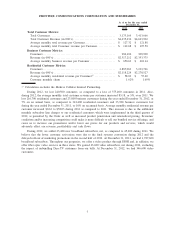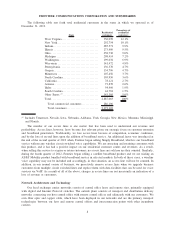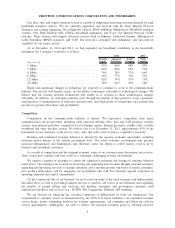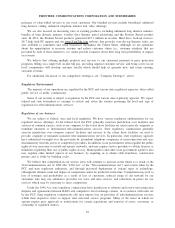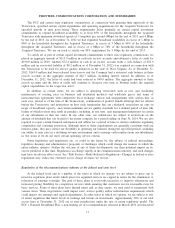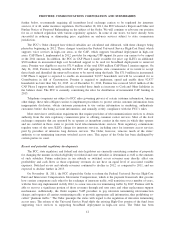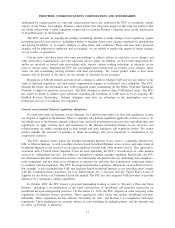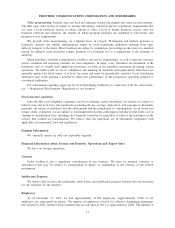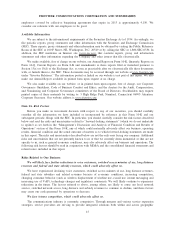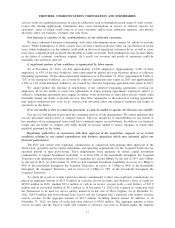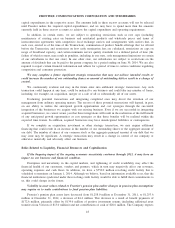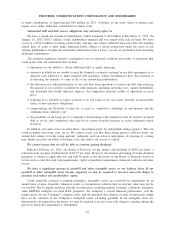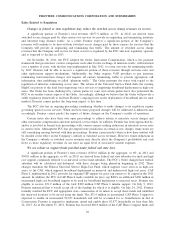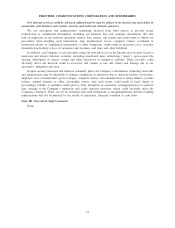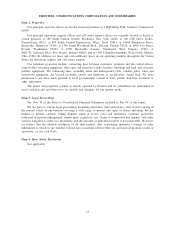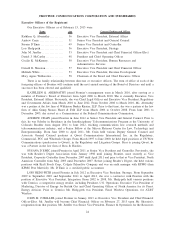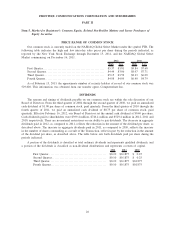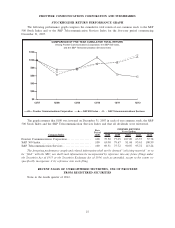Frontier Communications 2012 Annual Report Download - page 18
Download and view the complete annual report
Please find page 18 of the 2012 Frontier Communications annual report below. You can navigate through the pages in the report by either clicking on the pages listed below, or by using the keyword search tool below to find specific information within the annual report.services result in a significant increase in capacity utilization, such as through increased usage of video or peer-
to-peer file sharing applications. Disruptions may cause interruptions in service or reduced capacity for
customers, either of which could cause us to lose customers and/or incur additional expenses, and thereby
adversely affect our business, revenues and cash flows.
Our business is sensitive to the creditworthiness of our wholesale customers.
We have substantial business relationships with other telecommunications carriers for whom we provide
service. While bankruptcies of these carriers have not had a material adverse effect on our business in recent
years, future bankruptcies in the industry could result in the loss of significant customers by us, as well as cause
more price competition and increased uncollectible accounts receivable. Such bankruptcies may be more likely
in the future if economic conditions stagnate. As a result, our revenues and results of operations could be
materially and adversely affected.
A significant portion of our workforce is represented by labor unions.
As of December 31, 2012, we had approximately 14,700 employees. Approximately 9,200 of these
employees, or 63% of the total workforce, were represented by unions and were therefore subject to collective
bargaining agreements. Of the union-represented employees as of December 31, 2012, approximately 6,600, or
72% of the unionized workforce, are covered by collective agreements that expire in 2013 and approximately
1,200, or 13% of the unionized workforce, are covered by collective bargaining agreements that expire in 2014.
We cannot predict the outcome of negotiations of the collective bargaining agreements covering our
employees. If we are unable to reach new agreements or renew existing agreements, employees subject to
collective bargaining agreements may engage in strikes, work slowdowns or other labor actions, which could
materially disrupt our ability to provide services. New labor agreements or the renewal of existing agreements
may impose significant new costs on us, which could adversely affect our financial condition and results of
operations in the future.
If we are unable to hire or retain key personnel, we may be unable to operate our business successfully.
Our success will depend in part upon the continued services of our management. We cannot guarantee that
our key personnel will not leave or compete with us. The loss, incapacity or unavailability for any reason of
key members of our management team could have a material impact on our business. In addition, our financial
results and our ability to compete will suffer should we become unable to attract, integrate or retain other
qualified personnel in the future.
Regulatory authorities, in connection with their approval of the acquisition, imposed on us certain
conditions relating to our capital expenditures and business operations which may adversely affect our
financial performance.
The FCC and certain state regulatory commissions, in connection with granting their approvals of the
Transaction, specified certain capital expenditure and operating requirements for the Acquired Territories for
specified periods of time post-closing. These requirements focus primarily on certain capital investment
commitments to expand broadband availability to at least 85% of the households throughout the Acquired
Territories with minimum download speeds of 3 megabits per second (Mbps) by the end of 2013 and 4 Mbps
by the end of 2015. As of December 31, 2012 we had expanded broadband availability in excess of 1 Mbps to
86% of the households throughout the Acquired Territories, in excess of 3 Mbps to 84% of the households
throughout the Acquired Territories, and in excess of 4 Mbps to 78% of the households throughout the
Acquired Territories.
To satisfy all or part of certain capital investment commitments to three state regulatory commissions, we
placed an aggregate amount of $115.0 million in cash into escrow accounts and obtained a letter of credit for
$190.0 million in 2010. Another $72.4 million of cash in an escrow account (with a cash balance of $23.9
million and an associated liability of $0.2 million as of December 31, 2012) was acquired in connection with
the Transaction to be used for service quality initiatives in the state of West Virginia. As of December 31,
2012, $145.0 million had been released from escrow and the Company had a restricted cash balance in these
escrow accounts in the aggregate amount of $42.7 million, including interest earned. In addition, as of
December 31, 2012, the letter of credit had been reduced to $40.0 million. The aggregate amount of these
escrow accounts and the letter of credit will continue to decrease over time as Frontier makes the required
17
FRONTIER COMMUNICATIONS CORPORATION AND SUBSIDIARIES


